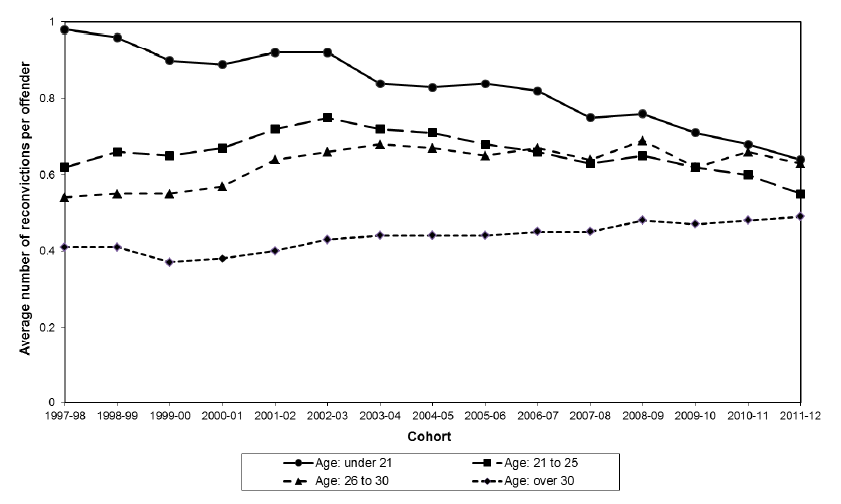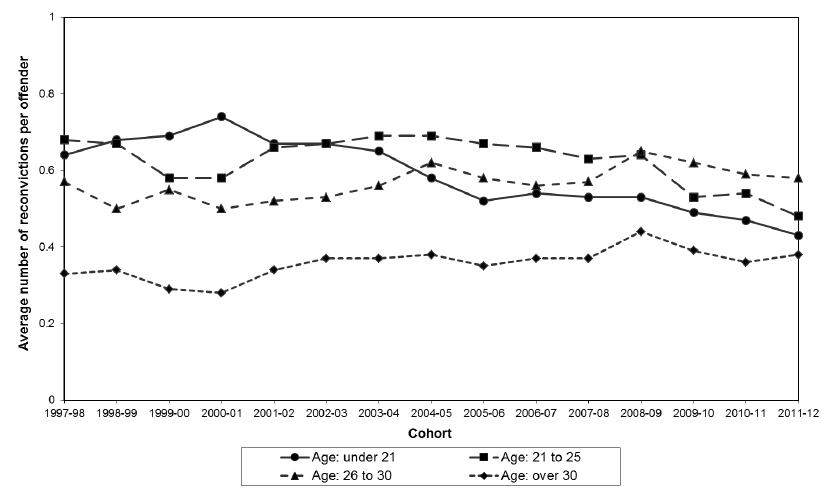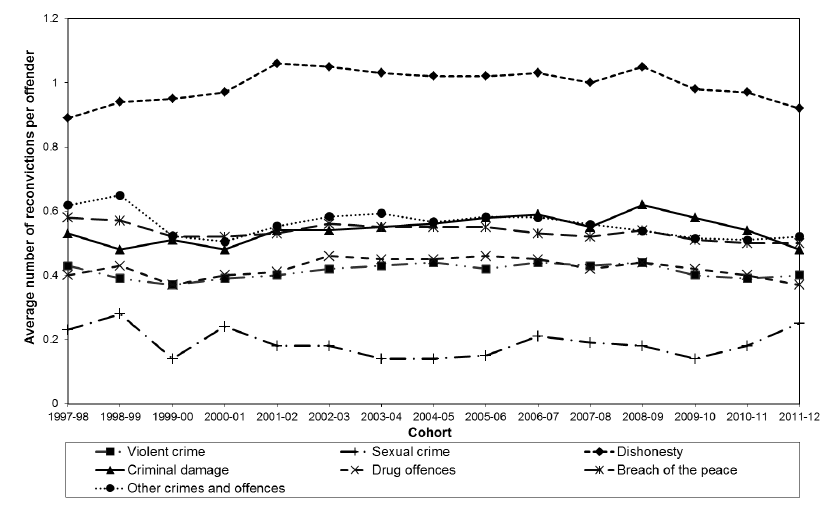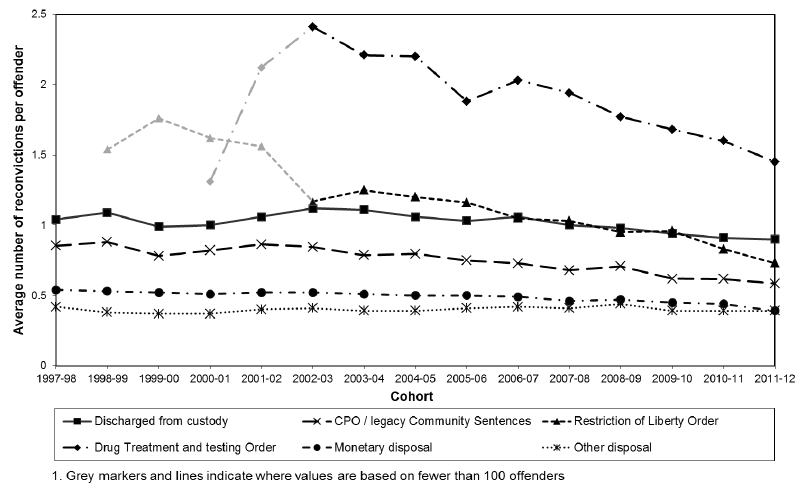Reconviction Rates in Scotland: 2011-12 Offender Cohort
This publication provides analyses of trends in reconviction figures up to the latest cohort of 2011-12.
This document is part of a collection
4 Main findings: reconviction rates for court disposals (Tables 1 to 12)
4.1 There were 43,826 offenders discharged from custody or given a non-custodial sentence in 2011-12 (Table 1), a number which has been declining every year from 53,301 in 2006-07.
4.2 In 2011-12, 29.2 per cent of offenders were reconvicted within a year and the average number of reconvictions per offender was 0.53. (Table 1 and Chart 1). Both of these measures have decreased every year since 2008-09. There has been a reduction in the reconviction rate by 2.3 percentage points from 31.5 per cent in 2008-09. The average number of reconvictions has decreased by 12 per cent from 0.60 in 2008-09.
4.3 The reconviction rate and average number of reconvictions per offender (Table 1 and Chart 1) have been generally declining from a high of 32.9 per cent and 0.64 reconvictions, respectively, in 2002-03. These declines in the ten years between 2002-03 and 2011-12 represent a decrease in the reconviction rate by 3.7 percentage points, and a decrease in the average number of reconvictions by 17 per cent. These reductions are also set against the context of a falling number of crimes and offences recorded by the police since 2004-05 (Recorded Crime in Scotland, 2012-13). Crime and victimisation surveys also reveal a similar pattern of falling incidence of crime (Scottish Crime and Justice Survey, 2012-13).
Age and gender
4.4 Males have higher reconviction rates and a higher average number of reconvictions per offender than females (Table 2). The average number of reconvictions per offender for the 2011-12 cohort was 0.55 for males, and 0.44 for females. The reconviction rates were 30.4 per cent for males and 23.6 per cent for females.
4.5 Offenders under the age of 21 have the highest reconviction rate of all the age groups, but for the first time this age group did not have the highest average number of reconvictions per offender (Table 3). For the 2011-12 cohort, the reconviction rate decreased for the under 21 age group by 1.5 percentage points, from 36 per cent in 2010-11 to 34.5 per cent in 2011-12. The average number of reconvictions per offender for this age group was 0.61, a fall of 0.04 reconvictions per offender, on average, from 0.65 in the 2010-11 cohort.
4.6 10 years ago, there was a large difference in the average number of reconvictions per offender, between offenders aged under 21 and those aged 21 and over, but the difference between these two age groups was less pronounced in the 2011-12 cohort (Table 3, Chart 3, and Chart 4). In 2002-03 the average number of reconvictions per offender for the under 21 age group was 0.88 and for those aged over 21 it ranged from 0.42 to 0.74. In 2011-12 the average number of reconvictions per offender of the under 21 age group was 0.61, which is substantially lower (31 per cent lower) than it was in 2002-03, and much closer to that for offenders aged over 21, which ranged from 0.47 to 0.62. In the same period, the reconviction rate of the under 21 age group decreased 6.8 percentage points from 41.3 per cent in 2002-03 to 34.5 per cent in 2011-12.
4.7 There has been a general decline in the reconviction rate and average number of reconvictions per offender in the 21 to 25 age group over the past ten years. In 2002-03, the reconviction rate was 37.1 per cent, and the average number of reconvictions per offender was 0.74. In 2011-12 the reconviction rate was 30.7 per cent, a reduction of 6.4 percentage points; and the average number of reconvictions per offender was 0.54, a 27 per cent reduction.
4.8 The older age groups haven't showed the same drops in reconviction rate and the average number of reconvictions as the younger age groups. The figures for the 26 to 30 year age group and the over 30 age group have been fluctuating over the past 10 years (Table 3). The reconviction rate for the 26 to 30 year olds has fluctuated between a high of 35.6 and a low of 32.4 per cent between 2002-03 and 2011-12, and between 25.6 and 24.1 per cent for the over 30s. In the same 10 year period, the average number of reconvictions per offender has fluctuated between a high of 0.68 and a low of 0.62 for the 26 to 30 age group, and between 0.47 and 0.42 for the over 30 age group.
4.9 In 2011-12 the 26 to 30 age group had the highest average number of reconvictions per offender of any of the age groups (Table 3), whereas the over 30s had the lowest. The average number of reconvictions per offender for offenders between 26 and 30 was 0.62, which is slightly higher than 0.61 for the under 21 age group, and is 32 per cent higher than 0.47 for the over 30 age group.
4.10 Males aged under 21 have the highest average number of reconvictions per offender and the highest reconviction rate of any age-gender combination (Table 4 and Chart 3). The average number of reconvictions per offender was 0.64 for the 2011-12 cohort, and the reconviction rate for this age group was 36.3 per cent.
4.11 Between 2006-07 and 2011-12 there has been a decline in the average number of reconvictions per offender for female offenders aged 25 and under (Table 5 and Chart 4). The under 21 age group decreased from 0.54 to 0.43 and the 21 to 25 age group decreased from 0.66 to 0.48.
4.12 The reconviction rate and average number of reconvictions per offender has been decreasing for females aged between 26 to 30 since 2008-09 (Table 5 and Chart 4). The reconviction rate for females in 2008-09 was 32.4, and in 2011-12 it was 28.7 per cent, a decrease of 3.7 percentage points. The average number of reconvictions per offender has decreased from 0.65 to 0.58, a decrease of 11 per cent.
4.13 In contrast to females, the figures for males between age 26 and 30 haven't seen a decline in recent years, and have been fluctuating over the past 10 years (Table 4 and Chart 3). The reconviction rate for males aged 26 to 30 between 2002-03 and 2011-12 has fluctuated from a high of 36.6 per cent and a low of 33.2 per cent, and the average number of reconvictions per offender between 0.69 and 0.63.
4.14 The reconviction rates and average number of reconvictions per offender for males and females over 30 have generally been fluctuating over the past ten years. Between 2002-03 and 2011-12, the reconviction rate for males over 30 has fluctuated between a high of 26.4 and a low of 24.5 per cent, and between 22.7 and 20.2 per cent for females over 30. The average number of reconvictions per offender has fluctuated between a high of 0.49 and a low of 0.43 for males over 30, and between 0.47 and 0.42 for females over 30.
Chart 3 Average number of reconvictions per offender, males by age:1997-98 to 2011-12 cohorts

Chart 4 Average number of reconvictions per offender, females by age:1997-98 to 2011-12 cohorts

Index crime
4.15 An "index crime" is the crime which resulted in an "index conviction". The "index conviction" is the reference conviction which is determined by either: (a) the estimated release date for a custodial sentence imposed for the conviction, or (b) the sentence date for non-custodial sentences imposed for the conviction. Whichever conviction has the earliest of these dates in a given financial year is defined as the index conviction (see Section 11.2.1 and Section 11.4.6 for definitions).
4.16 Offenders who were convicted for lower level index crimes, which tend to be committed in higher volumes, are more likely to be reconvicted than those who commit more serious crimes. Offenders who were convicted of a crime of dishonesty, e.g. shoplifting (see Section 11.4.9 for crime groupings), have the highest average number of reconvictions and reconviction rate compared to index convictions for other crimes (Chart 5 and Table 6). For the 2011-12 cohort, the average number of reconvictions for offenders who were convicted of crimes of dishonesty was 0.92, and the reconviction rate was 41.9 per cent.
4.17 Offenders in the 2011-12 cohort who had an index crime of a sexual crime[2] had the lowest average number of reconvictions and the lowest reconviction rate of compared to index convictions for other crimes. The average number of reconvictions per offender was 0.25 and the reconviction rate was 12.6 per cent (Chart 5 and Table 6). There has been a slight rise in the number of reconvictions per offender with an index crime of a sexual crime since 2009-10. These higher numbers may in part be explained by a widening of the definition of rape in the new Sexual Offences (Scotland) Act 2009, which came into force in December 2010, and by increased reporting in the wake of high-profile cases. Also, as these averages are based on small numbers of offenders, it is difficult to discern whether this reflects a real rise, or whether it is just a slight between-year fluctuation.
4.18 Offenders from the 2011-12 cohort who had index crimes other than sexual crimes or crimes of dishonesty had an average number of reconvictions between 0.37 and 0.52. The reconviction rates were between 23.5 and 30.3 per cent (Chart 5 and Table 6).
4.19 Reconviction rates by more detailed crime types are also available in Table 12[3]. Offenders in the 2011-12 cohort who had an index crime of shoplifting and theft had the highest one year reconviction rates. Offenders convicted of these crimes had one year reconviction rates of 55 and 49 per cent, respectively. The majority of shoplifters who were reconvicted, were reconvicted for further crimes of dishonesty.
Chart 5 Average number of reconvictions per offender, by index crime:1997-98 to 2011-12 cohorts

Index disposal[4]
4.20 An index disposal is the sentence received for an index conviction (see Section 11.2.1 and Section 11.4.6 for definitions).
4.21 Offenders given a Drug Treatment or Testing Order (DTTO) have the highest average number of reconvictions and the highest reconviction rate compared to the other disposals (Table 7 and Chart 6). The number of offenders who received a DTTO in the 2011-12 cohort was 280 and the average number of reconvictions per offender was 1.45 for this cohort, and the reconviction rate was 56.1 per cent.
4.22 Over time there has been a large decline in the average number of reconvictions per offender for offenders who are given a DTTO. These orders were rolled out to Glasgow, Fife and Aberdeen between 1999 and 2002, and Edinburgh, Renfrewshire, Inverclyde and Tayside in 2002-03. For the 2002-03 cohort the one year average number of reconvictions per offender rate was 2.41 compared to 1.45 for the 2011-12 cohort, which is an average reduction of nearly one offence (0.94) per offender.
4.23 There has also been a decline in reconviction rates for those given DTTOs. The reconviction rate for 2011-12 was 56.1 per cent, compared to 75.5 per cent for 2002-03.
4.24 Those offenders released from a custodial sentence in the 2011-12 cohort had a higher reconviction rate and average number of reconvictions than offenders given any other disposal except a DTTO. The reconviction rate for offenders released from custody in the 2011-12 cohort was 43.8 per cent and the average number of reconvictions per offender was 0.90.
4.25 Community Payback Orders (CPOs) were introduced by the Criminal Justice and Licensing (Scotland) Act 2010 and came into effect from 1 February 2011. The CPO replaces provisions for Community Service Orders (CSO), Probation Orders (PO) and Supervised Attendance Orders (SAO) - the "legacy" orders - for any offences committed after this commencement date. As a result, the legacy orders are now mainly being used in cases which have taken longer to progress from the offence being committed to sentencing in court. This may bias comparisons with other types of sentence and so reconviction rates for the legacy orders have been grouped with those for the CPO. In line with previous bulletins, SAOs are still grouped under "other", due to the small numbers issued.
4.26 There were 9,890 offenders given a CPO/legacy community sentence in 2011-12. This cohort had a 32.5 per cent one year reconviction rate and the average number of reconvictions per offender was 0.58.
4.27 The average number of reconvictions per offender for all disposals show some evidence of a decline over the past 10 years since 2002-03. While there is a gradual decline in reconviction rates for custodial sentences, this is set against a rising prison population during the same period. The complexity in relation to the drivers of the prison population is discussed in detail in the publication Prison statistics and population projections Scotland: 2011-12.
4.28 There was a substantial decrease in the number of individuals who were given a monetary disposal in a court in 2011-12 compared to 2007-08. There were 17,121 offenders with an index monetary disposal in 2011-12 compared to 27,492 in 2007-08. This may in part reflect the impact of Summary Justice Reform which was designed to take less serious cases out of the court system (see Section 5). During this period the average number of reconvictions fell from 0.46 to 0.39, a fall of 0.07 reconvictions per offender on average.
Chart 6 Average number of reconvictions per offender by index disposal: 1997-98 to 2011-12 cohorts

Sentence length of index conviction
4.29 Offenders who were released from a custodial sentence of 3 months or less have a higher reconviction rate and average number of reconvictions compared to those released from longer custodial sentences (Table 8). As mentioned above, offenders committing relatively low level crimes but in high volumes are more likely to be reconvicted, and these offenders are more likely to get short prison sentences. For those released from short sentences of under 3 months, the average number of reconvictions per offender was 1.32 for the 2011-12 cohort, and the reconviction rate was 58.9 per cent. On the other hand, offenders released from sentences of over 4 years had an average number of reconvictions of 0.15 and a reconviction rate of 13.3 per cent in 2011-12
Conviction history prior to index conviction
4.30 Conviction history is a strong predictor for the likelihood of reconviction, as reconviction rates increase with increasing numbers of previous reconvictions. Offenders with more than 10 previous convictions in the past 10 years have the highest reconviction rates, whereas offenders with no previous convictions in the past 10 years have the lowest reconviction rates. This pattern holds true even when age, sex, or disposal (all of which have an association with the likelihood of reconviction) are taken into account (Table 9 [5])
Two year rates
4.31 Historically the reconviction rates in Scotland have been reported with a two year follow-up period. From the 2009-10 cohort bulletin, the focus has been mainly on a follow-up period of one year rather than two years as, in general, the one year rate tracks the two year rate and has the benefit of being more timely.
4.32 When reconvictions are measured using a two year follow up period there has been a decline in the reconviction rate and in the average number of reconvictions per offender since 2005-06 (Table 11). For the 2005-06 cohort, the average number of reconvictions per offender was 1.13 and the reconviction rate was 44.8 per cent, whereas for the most recent cohort of 2010-11, these were 1.00 and 41.0 per cent, respectively. Overall, there has been a reduction of about 0.13 reconvictions per offender between 2005-06 and 2009-10, and a decrease in the reconviction rate by 3.8 percentage points.
Contact
Email: Andrew Morgan
There is a problem
Thanks for your feedback